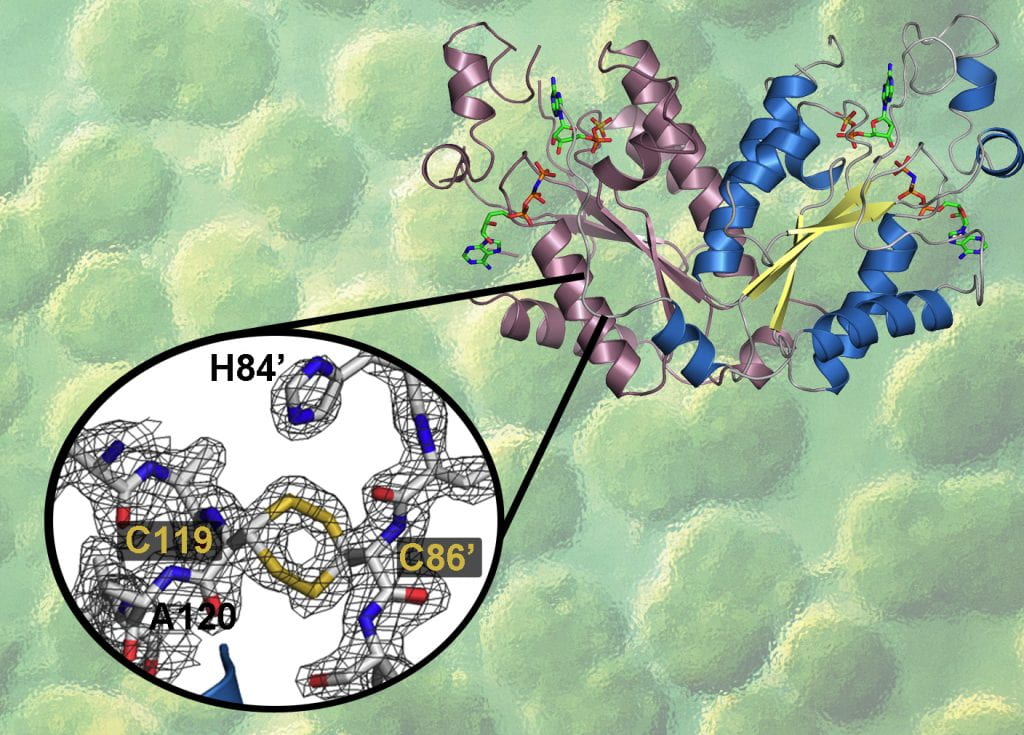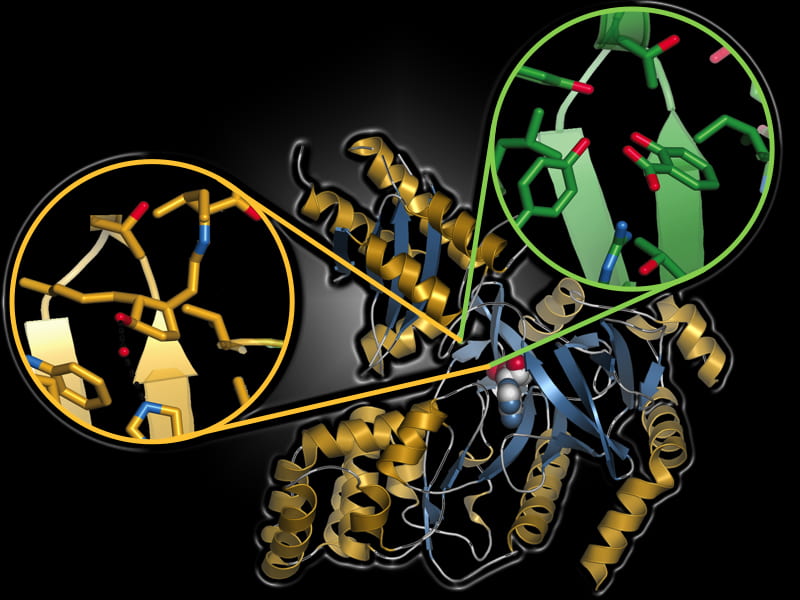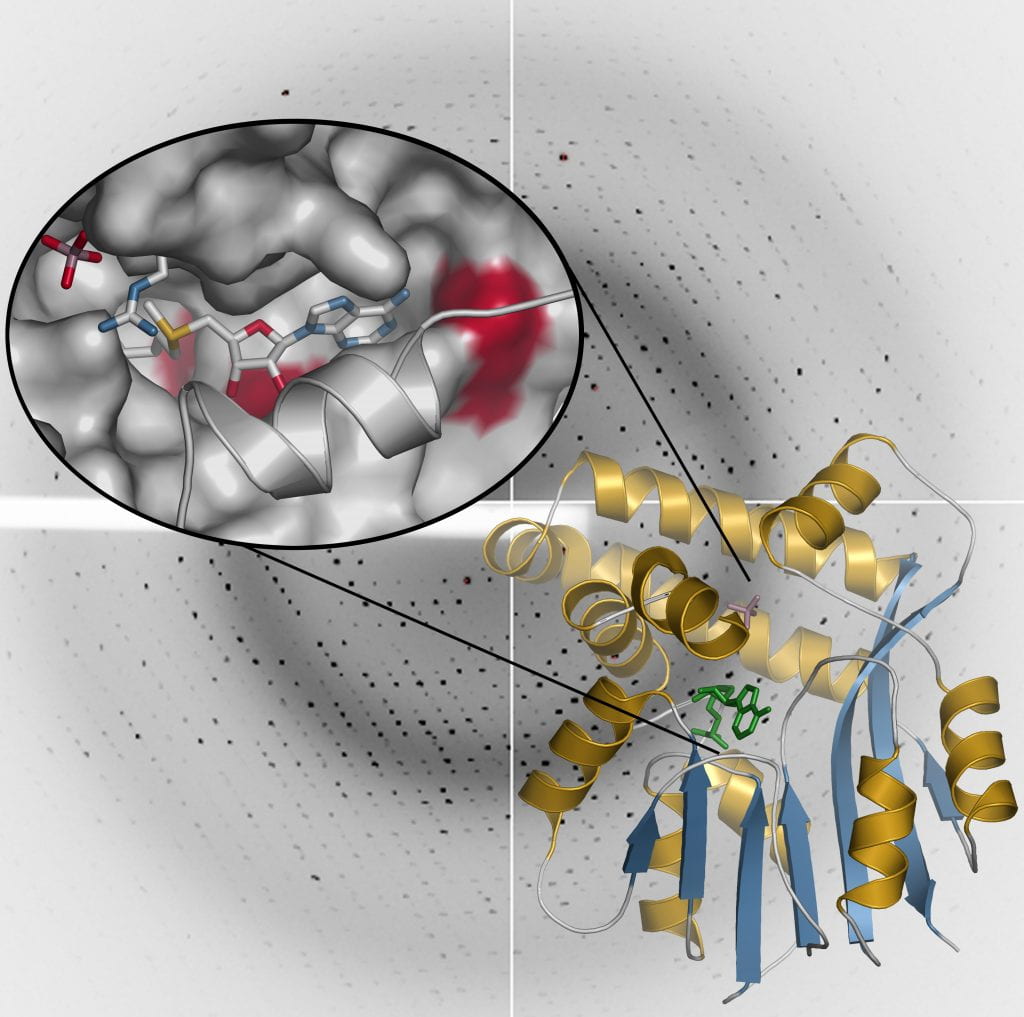
Figure 1. APS Kinase and Evolution of Redox Regulation 
Figure 2. Molecular Basis of Pre-Receptor Modulation of Plant Hormones by GH3 Proteins 
Figure 3. Plasmodium falciparum Phosphoethanolamine Methyltransferase – an Anti-Parasitic Target
Exploring Plant & Microbial Biochemistry: Structure, Function, and Regulation
Our research seeks to broadly understand how environmental changes re-model biochemical pathways in plants at the molecular, cellular, and organism levels with the aim of engineering these systems to address agricultural and environmental problems. Current work in the lab employs a combination of x-ray crystallography, enzymology, molecular biology, and plant biology to address the following questions: What are the biochemical networks involved in responding to specific stresses and how are they organized? How do different biochemical mechanisms regulate these pathways? What are the connective systems that allow for integration and crosstalk between metabolic pathways in plants? Can we re-engineer plant pathways and the links between different control systems to improve plant performance?
1. Metabolic Regulatory Networks and Environmental Responses in Plants
A fundamental challenge for plant biologists is to understand how plants respond to their environment to maintain growth, development, and propagation. Environmental changes lead to multiple adjustments across metabolic, signaling, and gene expression pathways. A major goal of my research program is to identify biochemical circuits that regulate these pathways and to understand the connective systems that allow for integration and crosstalk between dynamic biochemical layers in plants. Although much is known about the classical regulation of plant metabolism by control of substrate levels, feedback inhibition, and allostery, multiple studies suggest that higher levels of regulation play important roles in orchestrating adjustments in metabolism to meet cellular demands. We aim to develop a molecular view of how key proteins function in the context of metabolic pathways.
2. Molecular Control of Plant Hormone Responses
Plant development, growth, and fitness are all determined by the complex integration of multiple signaling pathways and hormone responses; however, perception by receptors is only one piece of this biological puzzle. A new project in the lab aims to elucidate how the GH3 protein family modulates plant hormone action. As part of the system that regulates plant hormone effects, the GH3 proteins play important, but poorly defined, roles, as evidenced by the various mutant phenotypes associated with these genes. The GH3 proteins appear to control levels of major plant hormones, including jasmonates and auxins, and modulate pathways for plant growth and development, seed development, light signaling, drought response, and pathogen resistance. Biochemically, the GH3 proteins catalyze the conjugation of amino acids to acyl acids via an adenylation reaction, which regulate levels of active and inactive forms of small molecules. Structural and mechanistic investigations are required to understand how these proteins catalyze hormone modifications and to decipher the determinants of both acyl acid and amino acid substrate specificity that allow GH3 proteins to modulate a wide range of plant hormone action.
3. Lessons from Plant Metabolism: Anti-Parasitic Targets
The worldwide impact of parasites on
human, animal, and plant life is profound.
Parasitic nematode and protozoan infections are a global cause of human
mortality and morbidity and result in considerable losses of livestock and
domestic animals. Likewise, plant
parasitic nematodes infect a wide-range of food crops and cause ~$125 billion
in losses annually. As drug-resistant strains of parasites emerge,
there is an urgent need to identify new biochemical targets for developing anti-parasitic
compounds. Our studies suggest that Caenorhabditis elegans and other nematodes, unlike other animals, use
a plant-like pathway as the major biosynthetic route to phosphatidylcholine. In this pathway, a pair of
phosphoethanolamine methyltransferases (PMT) catalyzes the sequential
methylation of phosphoethanolamine to phosphocholine, which can be incorporated
into phosphatidylcholine. Although RNAi
experiments demonstrate that both PMT are required for normal growth and
development of C. elegans, the
structural and molecular basis for how these enzymes function and their role in
phospholipid metabolism remain to be established. Because the PMT are highly conserved across nematode
parasites of humans, livestock, and plants, as well as in protozoan parasites,
understanding how these enzymes function and the identification of inhibitors
will aid in the
development of new anti-parasitic compounds of potential medical, veterinary,
and agricultural value.